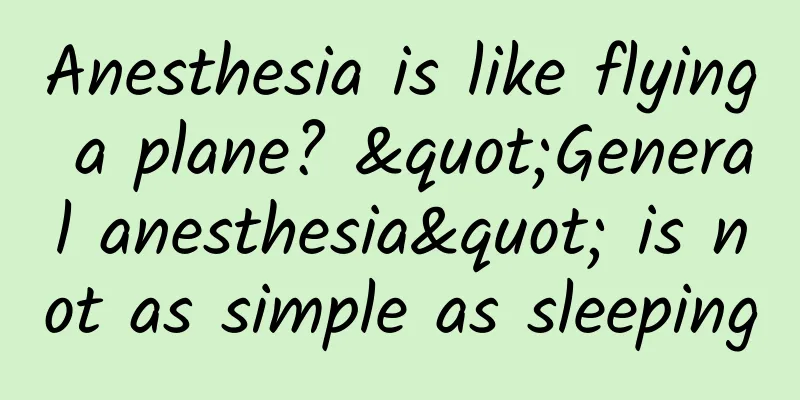Anesthesia is like flying a plane? "General anesthesia" is not as simple as sleeping

|
Anesthesia technology is one of the important milestones in the history of human medicine. The smooth progress of surgery depends to a large extent on the protection of anesthesia, which can make patients painless and comfortable. Anesthesia can quickly and safely relieve pain, eliminate anxiety, and fully relax muscles to facilitate surgical and other interventional procedures. The most important thing about perioperative anesthesia management is to maintain the patient's various indicators in a relatively stable state. Many people compare anesthesia to flying a plane, because the patient's safety must be guaranteed throughout the anesthesia process and there is no room for error. The team involved in anesthesia diagnosis and treatment includes anesthesiologists, anesthesia nurses, etc. The anesthesia medical team can provide services inside and outside the operating room, such as painless endoscopic examinations, interventional diagnosis and treatment, etc. Anesthesia services include preoperative evaluation, anesthesia implementation, anesthesia management, anesthesia awakening, and management of acute and chronic pain during the perioperative period. So how does the anesthesia medical team, as a pilot, smoothly fly the plane to take off and land? Generally, the following factors will affect the patient's choice of anesthesia method: surgical requirements, expected operation time, patient's condition and preference, anesthesia staff experience, etc. Any anesthesia method has advantages and disadvantages. The key is that the anesthesia staff can take active measures to reduce complications based on the patient's basic conditions. Commonly used anesthesia methods include: general anesthesia, spinal anesthesia, nerve block anesthesia, local anesthesia, etc. General anesthesia is an anesthetic that acts on the central nervous system and inhibits its function, making the patient painless and thus cooperating with surgery or examinations. Since general anesthesia can quickly and safely control pain and eliminate anxiety, it is suitable for most surgeries. Before planning an operation, the anesthesiologist will evaluate the patient's anesthesia, assess the anesthesia risk based on the patient's condition, and develop a plan. Patients with contraindications or high anesthesia risks may need to complete examinations or preoperative preparations, which can be understood as airport security checks. Only through complete and detailed security checks can the safety of aircraft operations be guaranteed. The implementation of general anesthesia is divided into three different stages: induction, maintenance and awakening. The purpose of general anesthesia is to achieve loss of consciousness in the patient; amnesia; moderate analgesia; achieve the appropriate state of muscle relaxation required for surgery; and block the body's response to harmful surgical stimuli. The anesthesia induction stage is equivalent to the take-off stage of an airplane. General anesthesia can be induced by using three types of drugs: analgesics, sedatives, and muscle relaxants to put the patient into an anesthesia state to cooperate with the surgery. During anesthesia induction, it is necessary to closely monitor the changes in the patient's various indicators and deal with them in a targeted manner to avoid sudden accidents. Many patients' deepest impression before going to sleep under general anesthesia is that a mask covers their mouth and nose and they quickly lose consciousness, so they think that general anesthesia is achieved by inhaled anesthetics. In fact, general anesthesia can be achieved using intravenous anesthetics and inhaled anesthetics. Most adult patients often prefer intravenous induction. The dosage of the drug depends on individual conditions. Factors that affect the dosage include weight and other patient factors and whether other drugs are used at the same time. The anesthesiologist will determine the dosage based on the patient's condition to ensure the anesthetic effect without causing serious adverse effects on the patient due to drug side effects. Then the operation begins and the anesthesia enters the maintenance period, which is equivalent to the stage when the plane is in flight. At this time, the blood concentrations of various anesthetic drugs tend to be stable. The anesthesia personnel need to adjust the dosage to maintain the appropriate depth of anesthesia, and monitor the patient's respiration, blood pressure, heart rate and other indicators to maintain them within the normal range. Anesthesia recovery refers to the process of gradual recovery of patient consciousness after the cessation of anesthetic and auxiliary drugs at the end of surgical operation. Most patients can smoothly transition from surgical anesthesia to a conscious state with complete protective reflexes. Generally, anesthesia medical staff will judge whether the patient is fully awake based on whether the patient can breathe evenly on his own, is conscious enough to communicate, can correctly follow instructions, and whether all indicators are stable. The anesthesia recovery period is often likened to the landing of an airplane, because at this time the surgical steps have been completed, and the anesthetic drugs need to be reduced and various drugs need to be discharged as quickly as possible to gradually restore the patient's consciousness and breathing. The plane can only be considered to have landed smoothly when the patient's vital signs are stable, he is fully awake, and has recovered well. If the patient does not wake up after the operation, delayed awakening may occur. Delayed awakening after general anesthesia means that the patient has not recovered to a conscious state with complete protective reflexes within 60 minutes after the last use of opioids, sedatives, hypnotics or other anesthetics. At this time, we should consider whether there are drug residues, metabolic disorders, severe hypothermia, etc. However, the modern medical environment has strict monitoring equipment and targeted antagonistic drugs, and the incidence of delayed awakening is gradually decreasing. After waking up from anesthesia, it is usually necessary to go through a period of observation to see if the patient has nausea and vomiting, unbearable pain, high or low blood pressure, etc. Targeted treatment will be given to ensure that the patient can be transferred safely, and then the patient will be transferred back to the ward to continue treatment. As the saying goes, "surgery cures diseases, anesthesia saves lives." The quality of anesthesia affects the safety of perioperative patients and their medical experience. How to ensure the quality and safety of anesthesia is receiving more and more attention. First of all, the anesthesia medical team is required to have solid professional basic knowledge, master the operating specifications of various anesthesia techniques, have flexible clinical thinking and adaptability, and be able to develop personalized anesthesia plans based on the patient's condition. It is also necessary to understand the characteristics of anesthetic drugs, rationally select and use drugs, precisely control medication and anesthesia depth, and continuously monitor various patient indicators to ensure the safety and reliability of the anesthesia effect. The improvement of anesthesia quality also depends on the technical support of scientific monitoring equipment. The development of modern medical technology makes the anesthesia process safer and more controllable. For example, anesthesia machines can provide precise anesthesia breathing support and parameter monitoring technology. It can enable anesthesia medical staff to understand the patient's anesthesia depth and other indicators in real time. In addition, medical institutions need to establish a complete operating specification and management system, strengthen the training of anesthesiologists, and provide necessary technical support and guidance. Because each link of anesthesia is complicated, the conditions of patients are different, and the requirements of surgery are also different, how to ensure the smooth progress of surgery through multi-pronged measures, and how patients can "get through the anesthesia" and "wake up" is definitely not as simple as giving an injection as everyone thinks. Whether the plane can take off and land smoothly requires multidisciplinary collaboration and the joint efforts of the surgical anesthesia team to improve the patient's medical experience. Author: Ma Yanli Department of Anesthesiology, Beijing Tsinghua Chang Gung Hospital Editor: Guru |
Recommend
How to acquire accurate users and achieve maximum conversion through SEO, SEM and WeChat public account operation
How to use SEO technology to double the website&#...
DianTao—Analysis of competitive products of Douyin live e-commerce!
In 2021, the "Taobao Live App" was offi...
Among so many monkeys, who is "Wukong"?
Recently, many netizens were instantly melted by ...
How much does it cost to customize the Qitaihe Electric mini program? What is the price quote for the customized Qitaihe Electric Mini Program?
The factors affecting the quotation of Qitaihe El...
At the end of the year, beware of "fires burning the entire business"... How can small shops pay attention to fire safety?
recently Dalongqinghe Market in Panyu District, G...
China Auto Rental has gained more young users, with revenue reaching 3.1 billion yuan in the first half of the year
On August 14, China Auto Rental released its 2018...
Solid coal turns into liquid fuel? This 100 billion-dollar project in China gives you the answer →
Author: Shi Xiangqi and Li Chuanfu On October 8, ...
How to monitor a typhoon that “runs” throughout its life?
Recently, this year's fifth super typhoon &qu...
If you encounter them, don't pick them randomly, it will be very "punishing" (Part 2)
We should not only protect wildlife We should als...
Why do many people feel pain all over their body after the age of 50? Doctors explain the reason
Many women feel pain all over their body after th...
From love to hate: Why did Microsoft abandon Nokia and WP brands?
After Microsoft completed the acquisition of Noki...
How to apply "system thinking" in operational work?
The principle of systems thinking itself is relat...
Murong "BOLL indicator technical tactics" boll indicator usage skills detailed video tutorial
Course Contents: Lesson 1: The role and goals of ...
The solution to fake KOL and fake traffic!
In the era of social marketing, KOL (key opinion ...
Information flow advertising | APP materials for tools, social networking, financial management, maternal and child care and other industries are exposed!
Friends often ask me why other people’s apps run ...









